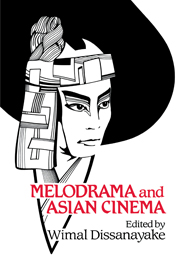Book contents
- Frontmatter
- Contents
- List of contributors
- Acknowledgments
- I Introduction
- II Melodrama / subjectivity / ideology: Western melodrama theories and their relevance to recent Chinese cinema
- III Symbolic representation and symbolic violence: Chinese family melodrama of the early 1980s
- IV The Goddess: Reflections on melodrama East and West
- V Melodrama as historical understanding: The making and unmaking of communist history
- VI Melodrama, postmodernism, and Japanese cinema
- VII Inscribing the subject: The melodramatization of gender in An Actor's Revenge
- VIII Insides and outsides: Cross-cultural criticism and Japanese film melodrama
- IX Psyches, ideologies, and melodrama: The United States and Japan
- X Negotiating the transition to capitalism: The case of Andaz
- XI The concepts of evil and social order in Indian melodrama: An evolving dialectic
- XII Politics of melodrama in Indonesian cinema
- XIII Power, pleasure, and desire: The female body in Filipino melodrama
- XIV The register of nightmare: Melodrama as it (dis)appears in Australian film
- XV Overview: What is American about film study in America?
- Index
I - Introduction
Published online by Cambridge University Press: 05 June 2012
- Frontmatter
- Contents
- List of contributors
- Acknowledgments
- I Introduction
- II Melodrama / subjectivity / ideology: Western melodrama theories and their relevance to recent Chinese cinema
- III Symbolic representation and symbolic violence: Chinese family melodrama of the early 1980s
- IV The Goddess: Reflections on melodrama East and West
- V Melodrama as historical understanding: The making and unmaking of communist history
- VI Melodrama, postmodernism, and Japanese cinema
- VII Inscribing the subject: The melodramatization of gender in An Actor's Revenge
- VIII Insides and outsides: Cross-cultural criticism and Japanese film melodrama
- IX Psyches, ideologies, and melodrama: The United States and Japan
- X Negotiating the transition to capitalism: The case of Andaz
- XI The concepts of evil and social order in Indian melodrama: An evolving dialectic
- XII Politics of melodrama in Indonesian cinema
- XIII Power, pleasure, and desire: The female body in Filipino melodrama
- XIV The register of nightmare: Melodrama as it (dis)appears in Australian film
- XV Overview: What is American about film study in America?
- Index
Summary
“Melodrama” comes from the Greek word melos, meaning song and originally denoted a stage play accompanied by music. According to the early nineteenth-century use of the term, melodrama meant a romantic and sentimental play that contained songs and music deemed appropriate for enhancing the situations presented on stage. It is generally believed that the French writer Jean Jacques Rousseau first used the term melodrame in this sense. “Pygmalion,” with liberetto by Rousseau, was first performed in Lyon in 1770, and is considered the first melodrama in the West. From France, the term spread to other European cultures. In later times, music ceased to be an integral part of melodrama, and the term came to signify a form of drama characterized by sensationalism, emotional intensity, hyperbole, strong action, violence, rhetorical excesses, moral polarities, brutal villainy and its ultimate elimination, and the triumph of good. The words melodrama and melodramatic, which were originally applied to stage plays, later came to be used to describe and evaluate aspects of literature and film.
Until very recent times, the term melodrama was used pejoratively to typify inferior works of art that subscribed to an aesthetic of hyperbole, and which were given to sensationalism and the crude manipulation of the audiences' emotions (Brooks 1976). However, the past fifteen years or so has seen a distinct rehabilitation of the term within film studies with the reexamination of such issues as the nature of representation in cinema and the role of ideology and female subjectivity in films.
- Type
- Chapter
- Information
- Melodrama and Asian Cinema , pp. 1 - 8Publisher: Cambridge University PressPrint publication year: 1993
- 7
- Cited by

